Discover what lies in waiting in this deck building worker placement exploration game.
20 minutes per person
Designer: Mín & Elwen
Artists: Jiří Kůs, Ondřej Hrdina, Jakub Politzer, František Sedláček, Milan Vavroň
Publisher: Czech Games Edition (CGE)
In our post late last year on “upcoming games we are excited for” [LINK] we wrote about Arnak:
“A combination deck building and worker placement game, say what? We love worker placement games but are just meh on deckbuilding, but the idea of combining these two mechanics is pretty intriguing. Throw in some resource management and they’ve pretty much got us hook, line, and sinker. The art and colors are striking which always bumps up a game for us as well”.
So did our excitement hold up or were we left lost amongst the ruins?
Well, you’ll have to wait and see.
First let’s talk about how the game plays for some context.
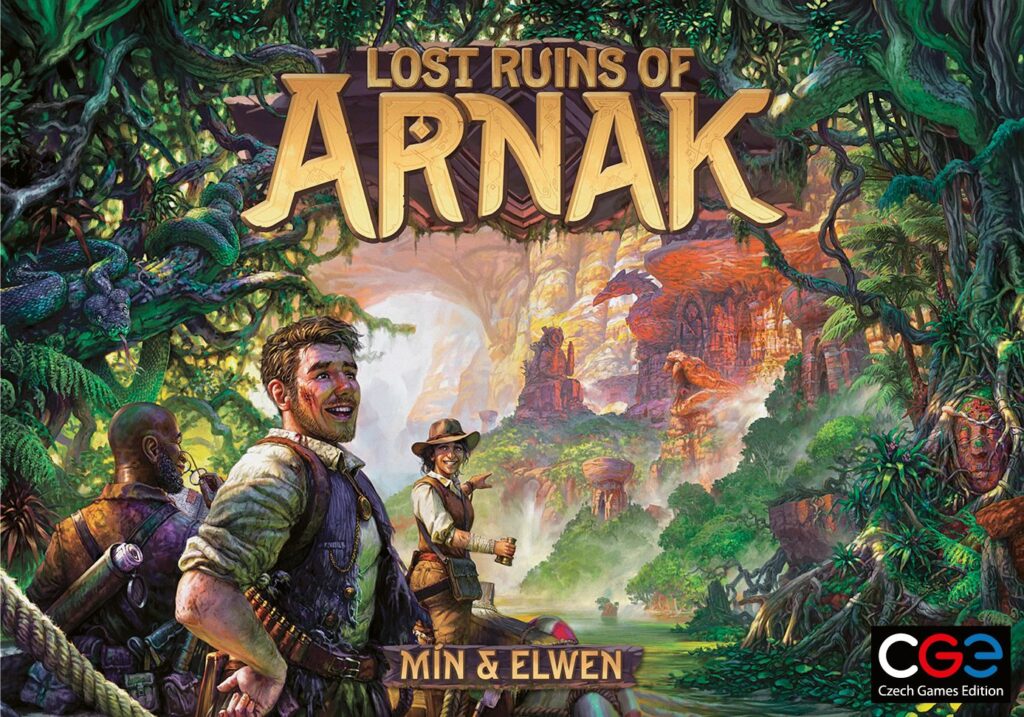
Gameplay Overview
This is a general overview to provide context for the review, not an in-depth how to play. Some rules might be glossed over or missing.
Lost Ruins of Arnak is played over five rounds. In each round, players take turns performing a series of actions that allow them to buy cards, place workers, and gain/spend resources. The size of the box and the amount of components included make this game seem much more complex at first glance.
Setup

There is a central board with 2 options: a beginner side (Bird Temple) and a more advanced side (Snake Temple).
Spoiler: we did not like the beginner side. Players who are experienced with medium and heavy resource management games could probably jump right to the Snake Temple side. Players who want to ease their way into this game should start with the beginner side.
Players begin the game with a player mat, 2 meeple workers (explorers), a starting deck of 6 predetermined cards, and a couple resources depending on turn order.
Turn Overview
In each round, players take turns performing a variety of different actions. The round begins by players drawing a hand of 5 cards from their deck.
Anytime Actions:
Many cards (and bonuses and assistants) depict an anytime action with a lightning bolt symbol. These do not count as a main action and, as the name implies, can be used at any time. However, using the anytime action on a card means you can’t use that card for its travel icon.
Actions Involving Cards from Hand:
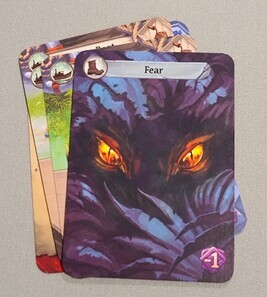
- Dig at a site: Each “site” (action space) has an associated travel cost that can be paid for using a card from your hand. Pay the travel cost, place your worker on the space, and gain the resources depicted
- Discover a new site: The main board has two areas of “undiscovered” action spaces. One costs three compasses to uncover, the other costs six but has better benefits (idols). Pay the compass cost, ADDITIONALLY use a card to pay the travel costs, place a worker at the site. Each site has an idol (or two) that you get for discovering there, along with that idol’s bonus. Reveal the new site from the stack of site tiles, gain the revealed resources of the site tile, and unveil a guardian – if you don’t pay the guardian cost (below) you gain a fear card which is negative points and clogs up your deck.
- Play a card for its effect – as you build your deck, you’ll add item and artifact cards with awesome effects
Actions Without Cards:
- Overcome a guardian: fight the scary thing in the jungle – you must have a worker at that site. Overcoming a guardian means you get that guardian tile, its one-time bonus, and 5 points.
- Buy an item (brown) card – these are added to the bottom of your face-down deck. They may have anytime actions or effects. All cards have travel icons and are worth at least 1 point at the end of the game.
- Buy an artifact (blue) card – these typically have stronger effects that can be activated immediately when purchased. They are added face-up to your discard pile (meaning it may be awhile before it gets into your hand again). All cards have airplane travel icons (the best) and are worth at least 1 point at the end of the game.
- Research: pay the associated costs to advance up the temple track, gain rewards for each advancement. There may be additional bonus tiles for being the first to reach certain spots.
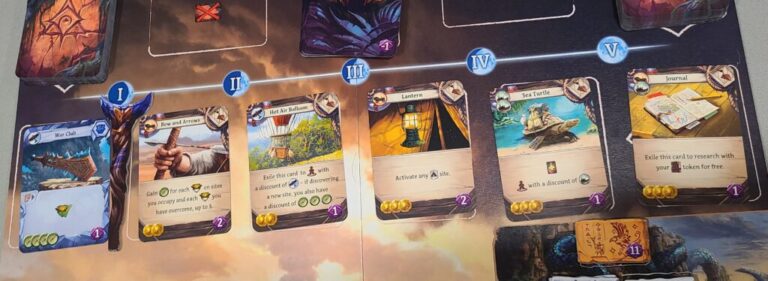
Pass: You're done for the round, no take-backsies
End of Game
The game ends after 5 rounds. The player with the most VPs (defeated guardians, idols, cards and temple track) wins. The game comes with a handy scoring pad that’s always a nice touch.
What do we think?
The game almost feels deceptively simple once you begin playing. There’s a lot of components and action options, but gameplay is relatively restrictive which (for us) made it quick to pick up and dive right into gameplay with some confidence.
Lost Ruins of Arnak is a study in game efficiency and that’s where the challenge lies. Do you spend your one crystal to research or to overcome a guardian? Is it worth going to a site that gives you a fear card along with some great resources? How many cards should you buy to keep your deck lean but useful?
Pro Tip: We’ve seen others mention this, but don’t treat this like an action chaining game where you build an awesome deck that gets you a ton of resources. It won’t work! You only draw up your hand 5 times in the game. Total. Sure, you might get a “draw card” bonus a few times, but not nearly often enough to justify a stacked deck. Instead, be super selective of your cards and keep it lean.
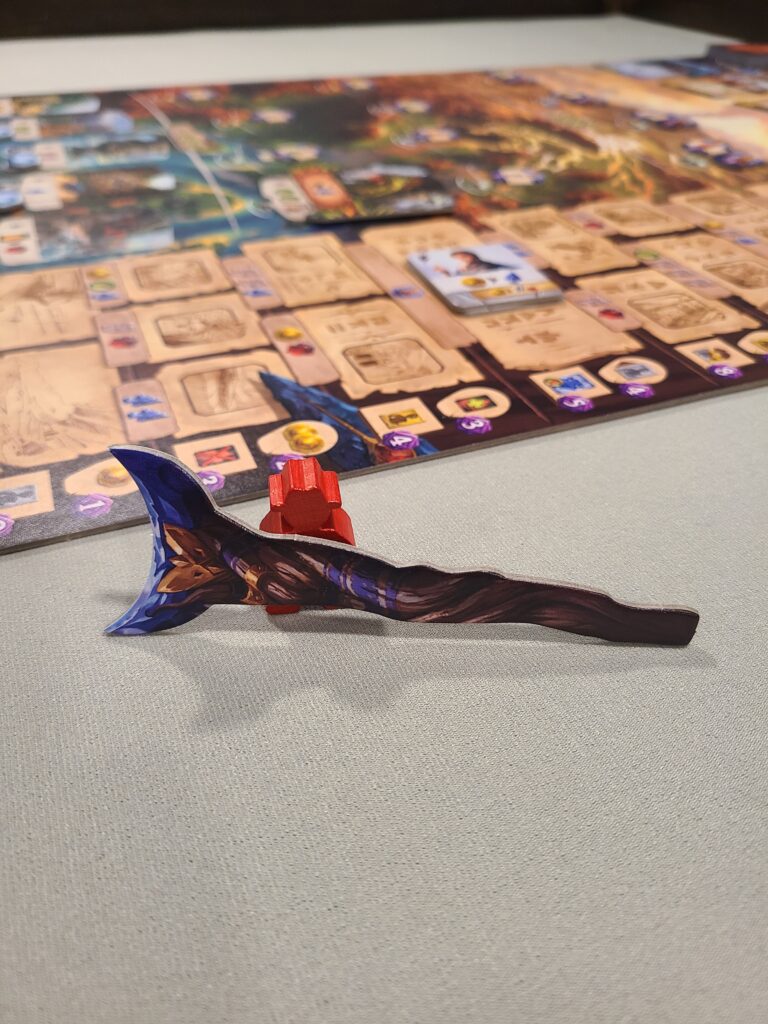
What did we like?
On every turn, there’s something to do which is always fun. The artwork and component quality is outstanding. The resources are satisfying to hold in your hand (and maybe jingle together if that’s your thing).
The interplay of mechanics is also well done. The “exploration” of new sites can be fun and weighing the benefit of exploration vs. gaining new artifact cards (which both cost a LOT of compasses) is an interesting brain-teaser. The way the costs of different things are balanced out (on the snake temple side) means that you have to make super tough decisions about how to use your very limited resources wisely.
And talk about theme integration! Everything about Arnak, from the board to the mechanics to the resources screams Indiana Jones-style adventure in a made-up world. It’s tough to get a strategy game to make so much sense with the theme, and they definitely nailed it. If you’ve always wanted to think like an explorer, this is a fun game for you!
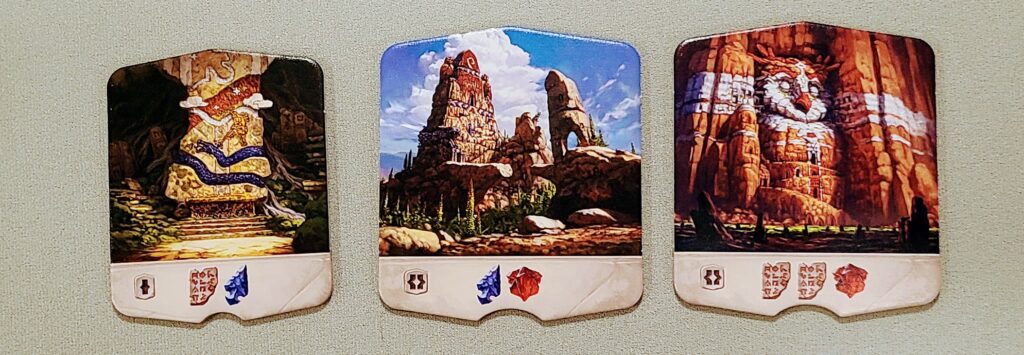
What didn't we like?
We mentioned earlier that we did not enjoy the entry level side of the board. We get it – it’s supposed to be a way to ease into the game and get a feel for it. But we think board gamers with experience in medium and heavy weight resource management might do as we did – play the beginner side, think the game is a tad boring – and start out with a negative first impression. The trouble is that the fun in this game comes from the restriction – resources are hard to get so you have to be very smart about how you spend. The beginner side of the board makes it super easy to get compasses, which made everything waaaaayyyy easier and took the tension out.
That being said, we can see how some people might not mind it as much, and might enjoy playing this game with fewer resource (compass) constraints.
The other thing that knocks this game down a peg for us is that the 2-player game feels like you’re sort of just waiting for the end. There’s not a ton of things that will “shake up” your strategy or force you to think and quickly react on your toes, so when you’re playing it’s almost like you’re completing actions as you’ve already laid them out in your head. Part of it is that there is a clear path to victory – rushing the research track – and players who don’t do this are definitely going to lose. This limits some of the re-playability for us, since your strategy becomes predictable. We didn’t get a chance (yet) to play at higher player count, but we do expect that this wouldn’t be as much of an issue because there would be more interaction.
Who will like this game?
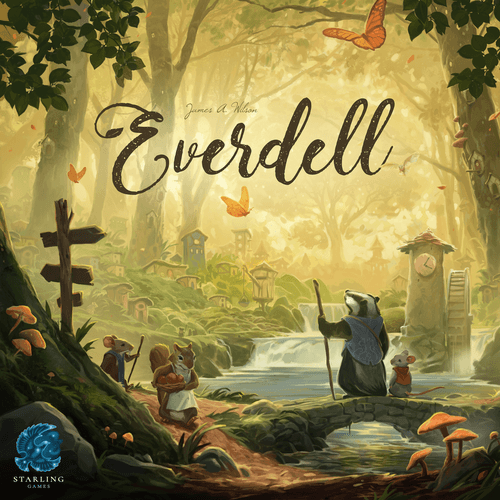
Lost Ruins of Arnak is a fun mix of mechanics that work pretty well together, but it might lose some of the fun after several plays (maybe not with enough time and different people?). Even though at first glance there appears to be a lot going on with all of the tiles on the board and piles of resources, the gameplay is straightforward, so this game would work for experienced board gamers and newcomers to modern board games who might want something a bit more challenging. The theme definitely will make it a better draw for people on the fence.
Want to play a fast game with tons of bits? Lost Ruins of Arnak is perfect.
If you’re a fan of Everdell (deck building and worker placement) or Fort (hand management) Lost Ruins of Arnak is definitely one you’d likely want to check out.
Sarah's Take
I’m going to go there. I am very meh Lost Ruins of Arnak. As a reviewer, saying you’re “meh” on a game that seems like everyone is totally hyped for feels a little bit like playing with fire. The mixing of the worker placement, deck building, and exploration is a fun meld, sure. You could even say this is Indiana Jones: the board game…but without any of the excitement or flying by the seat of your pants adventure.
Yes, there’s some suspense in flipping over the exploration sites and seeing what the requirements will be to defeat the guardian at the site are, but worst case scenario if you don’t defeat the guardian you get a fear card. Fear cards sound a lot scarier than they are. Unlike some other hand management or deckbuilding games, fear cards can actually be somewhat useful, but overall still burdensome in your deck. You can still use them to place a worker or as part of the put down a card effects.
I think my biggest issue is that there is a almost a pre-determined way to win – rush the research track. That does seem purposeful in how the game is designed, but it can get old after several plays. It also makes the game essentially a race game to see who can get up the research track fastest which is a bit repetitive.
Emily's Take
I disagree somewhat with Sarah on this game, which is super weird because usually I like very open games where I can gain and spend a million resources and Sarah usually likes games with tighter (read: restrictive) play. This game was made to stress me out and for Sarah to love, but it ended up the opposite. Am I pretty stressed the whole time? Yes, definitely. There are so many things I want to do and so, so few resources to do them. And yet, I liked the challenge of optimizing strategy and figuring out what works and what doesn’t.
Pro Tip: We’ve seen others mention this a few times, but this is a really lean deck builder. The cards are super cool, but if you buy too many you may not even see many of them.
I do think there’s some drawbacks to playing 2 player that knock it down for me. With more players, there would definitely be more interaction which this game needs to keep it interesting.
Rulebook / Learning the game
Publisher CGE is consistently one of the best publishers for rulebooks we’ve seen and Arnak is no exception. The rulebook is straightforward yet informative. It makes good use of pictures that both show and teach you the game. It also draws you into the “story” with flavor text which is fun.
Total time for Emily to read the rulebook, teach Sarah, and start playing was around 30 minutes. Clear iconography along with the incredible artwork definitely helps, and the player aide is spot-on.
First Play
Our first play was definitely a learning game. Several folks had warned us not to fall into the deckbuilding trap, but yet we did. Our first game, we both had ridiculous decks making it unlikely to see item cards come up multiple times (so, definitely don’t do that).
We also played our first game on the intro side of the board that rewards a compass for every level your magnifying glass marker advances on the track. While this is a great way to get a feel for the game, it does somewhat surprise you when you flip over to the snake temple side and realize that compasses are more difficult to come by. We honestly didn’t like the game much the first time we played.
Subsequent Plays
After the first play, we moved over to the Snake Temple side of the board. This created a more interesting research track action and added a bit of tension to the game that completely changed it. The iconography and rules explanation are good enough that we probably could have started with the Snake Temple side and just accepted that we’d make some bad decisions during the first play.
Parent Perspective
Interruptions
Interruptions are no problem at all, especially 2-player which has not as much interaction. We had no trouble leaving the table at any point to get the toddler a bedtime banana or to rub his back and coming back to pick up right where we started again.
Time Investment
Lost Ruins of Arnak plays super fast. If you’ve been paying attention to our reviews, we are always impressed by games that play fast but aren’t necessarily short or “filler” type games. A two player game can be played in about 40 minutes with an additional 10 minutes for setup/clean up.
Life Fit
This is definitely a weeknight game for us. We can get a game played in under an hour. Perfect for squeezing in a game even if the kiddos have a rough go at bedtime.
Rating
6/10
Overall, solid game that is not our favorite, but we wouldn’t say “no” to playing every once in awhile. Does it live up to the hype? For us, it does in some ways and falls short in others. No arguing the theme and artwork are awesome and the way the rules of the game line up with theme so well is clever. The cards are super interesting and the “explore” mechanic is fun. We think the rush for the research track is a bit repetitive and limits the fun of replaying it and we have several other games in this weight class/genre that we would probably go to first, especially playing 2 player. Given that, we can definitely see a lot of people liking this game, especially for those looking for a strategy game with a great theme and a lot of tension that plays in under an hour.
*See our rating scale HERE
Click through for more posts, or follow us on social media to see what we’re playing and for new post updates!

Great job you two….. Thank you so much for sharing😍
Aw thanks!